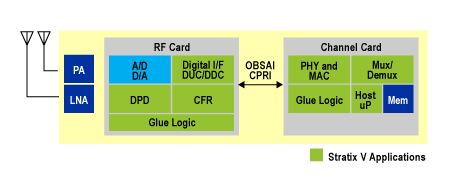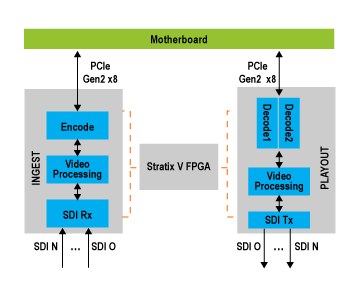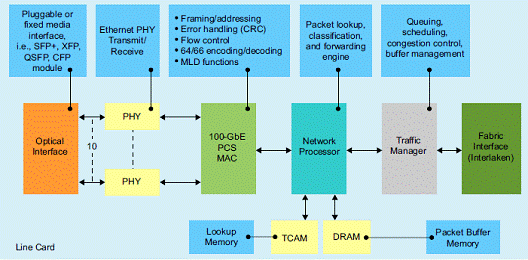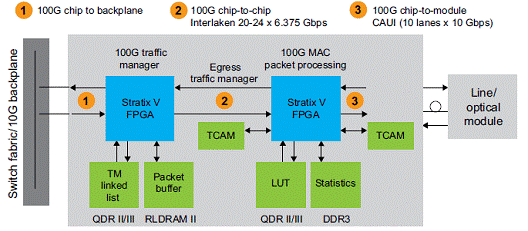
图6.RF卡和通路卡框图
RF卡和通路卡主要特性:
lReduced board space, power, and cost via fewer data channels and higher throughput per channel
lLower system latency and increased system performance and reliability via greater integration
lDesign differentiation using highest DSP- and memory-to-logic ratios
Higher MIMO and bandwidth density compared to competitive offering
6.Studio Video Server
图7.视频服务器框图
视频服务器主要特性:
Best-in-class serial digital interface (SDI) solution
Support for multiple CODECs through user-friendly partial reconfiguration
Optimal memory design with native 10-bit support
Efficient video processing with high multipliers-and memory-to-logic ratios
Complete solution via CODECs and 1080p video framework IP core
采用28nm FPGA的100GbE线路卡设计方案
The components of a 100-GbE line card include:
■ Optical interface—The optical interface unit can consist of multiple SFP+ or XFP modules, or it can be driven by 100G traffic via CFP or QSFP modules.
■ PHY—The PHY unit is the serializer/deserializer (SERDES) component of the line card. The PHY line rate and jitter specifications should be compliant with the optical interface.
■ MAC/PCS—The MAC/PCS unit performs the gearbox, scrambling, and encoding functions based on the protocol. In the case of 40-GbE or 100-GbE implementations, there is a multilane distribution (MLD) function as per the IEEE 802.3ba specifications. In addition, flow control as well as error handling is performed by the MAC.In some cases, the received 10G data from the MAC unit is aggregated before it is passed over to the network processing unit (NPU).
■ NPU—The key function of the NPU is to optimize the performance of packet processing in the evolving functional framework of the line card. Key functions include compression, classification/lookup, modification, and deep-packet inspection. The most common function of the NPU is to interface with a switch fabric device that performs complicated routing of the packets through the network.
■ Traffic manager—The primary function of the traffic manager is to offer a large number of high-speed queues, optimize queue depths, and use sophisticated scheduling mechanisms to meet the QoS requirements of the application. Because NPUs are not designed with QoS in mind, they require excessive processing power and software optimization before they can function as efficiently as a dedicated traffic manager.
图8。100-GbE线路卡元件框图
图9。采用两片Stratix V FPGA的100-GbE线路卡框图
100-GbE线路卡主要特性:
Higher system integration through highest density and hard PCS blocks for 40 GbE, 100 GbE, and Interlaken
High-bandwidth data-buffering with up to 1,600-Mbps external memory interfaces
Efficient implementation of packet processing and traffic management functions
Higher system performance while staying within your power and cost budget